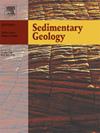影响阿根廷半干旱的Pampeanas山脉凝灰岩系统的建设性和破坏性过程
IF 2.9
2区 地球科学
Q1 GEOLOGY
引用次数: 0
摘要
本研究的重点是在阿根廷中部的sierra Pampeanas的中纬度半干旱气候下发展的现代凝灰岩系统,该系统目前正在退化。该研究综合了地貌学、沉积学、矿物学和水化学方法,分析了凝灰岩系统中的建设性和破坏性过程,以及它们在地层记录中的保存潜力。凝灰岩具有12.2米高的半圆锥形结构,坐落在Los Quebrachitos溪流和Cabana河汇合处的瀑布中,覆盖着富含大理石带的结晶基岩。确定的主要岩相为:生物热凝灰岩、层状凝灰岩结壳、砂质凝灰岩。此外,在瀑布的底部还形成了碎石凝灰岩沉积物。生物热凝灰岩主要由植物热成分和相关的无脊椎动物遗骸组成,具有不规则的凝块泥晶和球囊结构。在微观尺度上,微生物活动变得更加显著,其中蓝藻,硅藻和外聚合物物质有助于不规则层压织物的发展。层状凝灰岩壳由微晶、微空间晶和空间晶相间的低镁方解石层组成。Los Quebrachitos溪流属于淡水(总溶解固体在81.57至79.5 mg/L之间),微碱性(pH值在7.9至8.3之间),具有碳酸钙组成(Ca2+在23.10至26.16 mg/L之间,碳酸盐碱度在95.95至112.18 mg/L之间)。由于降雨引起的流量变化似乎控制着Los Quebrachitos系统中水的碳酸盐饱和状态。在旱季,曝气、低压和射流的共同作用增强了CO2脱气,使方解石处于微饱和状态(Ωcal = 1.1),促进微小水滴蒸发,从而诱发方解石降水。相反,降雨增加会稀释水,降低总溶解固体和方解石饱和度。目前,凝灰岩体系处于破坏阶段,表现为重力崩塌、树根定殖造成的生物破裂和地表侵蚀溶解特征。正在进行的破坏过程似乎超过了这个枯竭的碳酸盐系统的降水速率,主要是由于气候条件的变化。本文章由计算机程序翻译,如有差异,请以英文原文为准。
Constructive and destructive processes affecting a tufa system in semi-arid Sierras Pampeanas, Argentina
This study focuses on a modern tufa system developing under a semi-arid climate at mid-latitude in the Sierras Pampeanas of central Argentina, currently undergoing degradation. The research integrates a geomorphological, sedimentological, mineralogical, and hydrochemical approach to analyze constructive and destructive processes in tufa systems and their preservation potential in the stratigraphic record. The tufa features a 12.2-m-high, semi-conical structure, perched in a waterfall at the confluence of the Los Quebrachitos stream and Cabana River, overlying crystalline basement rocks rich in marble belts. The main lithofacies identified are: biohermal tufa, laminated tufa crusts, sandy tufa. Additionally, rubble tufa deposits occur at the base of the waterfall. Biohermal tufas are dominated by phytohermal components and associated invertebrate remains, with irregular clotted-micrite and peloidal fabrics. At the microscale, microbial activity becomes more significant, where cyanobacteria, diatoms, and exopolymeric substances contribute to the development of irregular laminated fabrics. Laminated tufa crusts consist of alternating micritic, microsparitic, and sparitic low-Mg calcite layers. The Los Quebrachitos stream, classified as fresh (total dissolved solids between 81.57 and 79.5 mg/L), slightly alkaline (pH between 7.9 and 8.3) waters, has a calcium-bicarbonate composition (Ca2+ between 23.10 and 26.16 mg/L, carbonate alkalinity between 95.95 and 112.18 mg/L). Flow rate variations, due to rainfall, appear to control the carbonate saturation state of waters in the Los Quebrachitos system. During dry season, the combined effects of aeration, low pressure, and jet flow enhance CO2 degassing, enabling slightly saturated conditions with respect to calcite (Ωcal = 1.1), promoting tiny water droplets evaporation, and thereby, inducing calcite precipitation. Conversely, increased rainfall dilutes water, reducing total dissolved solids and calcite saturation. Currently, the tufa system is in a destructive phase, showing gravitational collapse, bio-fracturing from tree root colonization, and surface erosion-dissolution features. The ongoing destructive processes seem to exceed the precipitation rates in this depleted carbonate system, mainly due to changes in climate conditions.
求助全文
通过发布文献求助,成功后即可免费获取论文全文。
去求助
来源期刊

Sedimentary Geology
地学-地质学
CiteScore
5.10
自引率
7.10%
发文量
133
审稿时长
32 days
期刊介绍:
Sedimentary Geology is a journal that rapidly publishes high quality, original research and review papers that cover all aspects of sediments and sedimentary rocks at all spatial and temporal scales. Submitted papers must make a significant contribution to the field of study and must place the research in a broad context, so that it is of interest to the diverse, international readership of the journal. Papers that are largely descriptive in nature, of limited scope or local geographical significance, or based on limited data will not be considered for publication.
 求助内容:
求助内容: 应助结果提醒方式:
应助结果提醒方式:


